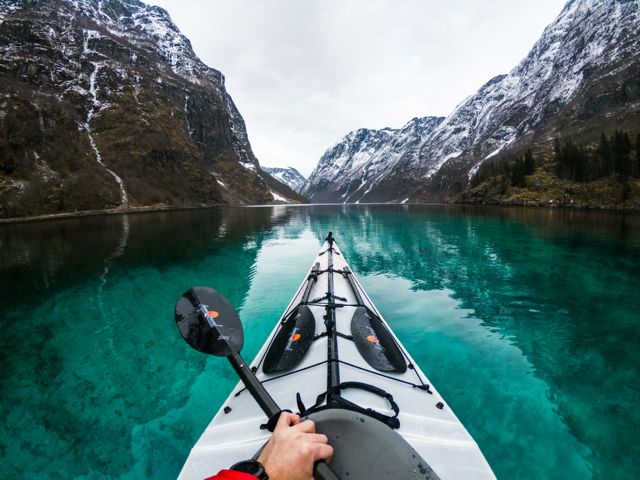Choosing A Kayak Paddle
If you're new to kayaking or would just like to learn more about some of the different types of kayak paddles, this is a great place to start…

Every journey starts with a single step and your search for the right paddle is no different. This journey's first step is a question you'll need to have an answer for: What type of paddling adventure will you most frequently be embarking on?
Recreational kayak paddles are a class of paddles that are ideal for short trips, fishing, exercise and shore exploration. They're normally made of a combination of aluminum and fiberglass or plastic.
If you'll mainly be paddling on lakes and slow-moving rivers, or are planning on some longer trips, a touring kayak paddle would be a good choice.
Performance kayak paddles are normally the high-end versions of the touring or recreational type paddles and are constructed with the most advanced materials on the market: fiberglass and carbon for ultimate performance.
Now that you have a general idea of the different classes of paddles, next we’ll take a look at the main factors that go into a paddle’s design.
Blade & Shaft Design
The wider a paddle’s blade, the more bite it will provide in the water, which translates to more power with each stroke. This additional power will help you maneuver the kayak more quickly left and right and also provide faster forward acceleration.
So if you're going to be in technical water where kayak control is paramount or if you have a wider kayak that requires more “oomph” to get around, a paddle with a wider blade design would be a great choice. These are called high-angle blades.
On the flip side, if you're planning on longer trips with extended paddling time on fairly flat waters and/or will be paddling a kayak that is narrower than, say 25” wide, a paddle with a thinner blade would be the way to go.
With the thinner, longer blade you'll experience less resistance with each stroke, allowing you to go further with less fatigue. These are called low-angle blades.
For more, read: Kayak Paddles: High-Angle vs. Low-Angle
When it comes to the shaft, there's quite a bit that goes into the design, but it all boils down to a couple of choices.
First, choosing a bent vs straight shaft. Straight shafts are most common as they can be used for all types of paddling. Bent shafts are created mainly to provide a more natural wrist positioning, which is great for paddlers with arthritis, carpal tunnel or any other wrist issues.
The negatives of a bent shaft are: you can't move your hand positioning, and you're going to pay significantly more (compared to a straight-shafted paddle). Loosening your grip on the shaft—clamping down with only your pointer-finger and thumb—can provide the same benefits of a bent-shaft paddle.
While doing your research, you may see that a paddle’s blades can be symmetrical or asymmetrical. A symmetrical blade shape is able to be paddled with either hand, since both sides of the blade are the same. An asymmetrical blade provides for a smoother transition through the water but must be held and paddled a certain way.
Another common term you’ll come across is feathering. The feather of a paddle refers to the angle that each blade is offset from each other. The main reasons for feathering are: to reduce wind resistance on the paddle blade, and increase your paddling efficiency when dealing with a variety of water and wind conditions. 15-degree increments are common. Some paddles offer unlimited feathering angles, like our paddles that offer the Posi-Lok ferrule option.
For more, read: Kayak Paddle Feathering: What Is It and Why Does It Matter?
Blade & Shaft Material
There are several types of materials that can be used to construct a kayak paddle. From plastic and aluminum to fiberglass and carbon. A paddle’s durability, performance, weight and price are all impacted by the material used.
Plastic and aluminum paddles are the least expensive, heaviest and most likely to need replacing. Fiberglass and carbon provide a lighter, more durable paddle with optimum performance, but will also come at a higher price.
Paddle Length
The final item we’ll go over here is your paddle length. No matter how much time you’ve put into researching design and material, if you end up with a paddle that's too long or too short for you, you’ll truly be missing the boat (pardon the pun!) and your paddling experience can be greatly hindered.
To find the right paddle length for you, check out the sizing section in our Kayak Paddle Sizing Guide.
The two most important factors to consider are:
1. Knowing the dimension of your kayak, particularly its width. You need to make sure you have a paddle that will comfortably reach the water without banging on the sides of the boat or being too far out from the sides.
2. Paddler torso size and level of fitness. Two people who are 6-feet tall may not use the same length paddle. If it was a SUP paddle, it would be the same—but since you sit when paddling a kayak, the most important distance is the length of your torso. Likewise, a 6-foot person who's very active and physically fit may be more ready to handle a more aggressive paddle than someone just starting out or not very physically fit.
(You can find detailed charts on our Kayak Paddle Sizing Guide)
Kayak paddling at any level can be an extraordinary experience. To increase your chances of enjoyment, take time to do the research needed to choose a paddle that truly fits you and will be best for your paddling environment and style.
Do you have questions for our friendly customer service team? Call or email today: 715-755-3405 • sales@aquabound.com
More for you…





